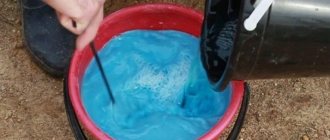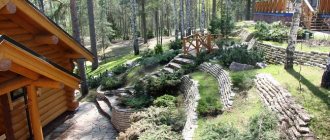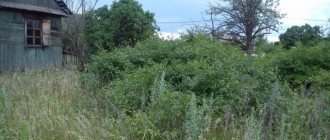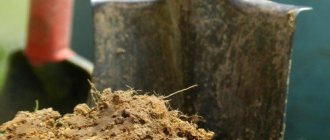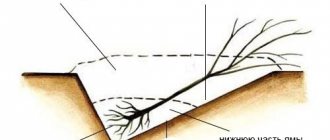When alignment is required
In order to pour the foundation for a building, naturally, a flat surface is necessary. The permissible slope of the surface should not exceed a couple of degrees, and the slope should face the south. If the site is on a steeper slope, you need to bring in soil and choose the right material for the retaining walls. Otherwise, the soil will creep down. If it is necessary to improve the yard area, it is necessary to lay out paths to get to any corner of the site. To implement your plan, you need to remove all irregularities from the surface.
To plant a vegetable garden, the area must be level, then the moisture will be evenly distributed over the entire surface. Otherwise, the elevations will be dry, and stagnation of water in the holes can lead to rotting of the root system of planting crops.
The best time for leveling is autumn. All flat areas are dug up by hand and left until spring. Under the influence of rain, snow and temperature changes, the earth will settle and absorb useful substances. In spring, the soil will be ready for planting a vegetable garden.
By leveling the surface on the site, you will not only provide better conditions for the growth of crops, your site will look impeccable from an aesthetic point of view. In such an area it is easy to organize a corner for relaxation, create flower beds or place a designer decoration.
Advice from experienced people
When planning earthworks, it is useful to take into account the recommendations of those who have already carried out the development of land plots:
It is better to level areas larger than five acres using heavy equipment.
In low-lying areas, it is better to arrange beds - just bring fertile soil there with a machine. It is best to level humus, peat, and black soil in a dry state. Paths are made of boards for the wheelbarrow.
In free areas along future paths, turf is preserved; it will prevent excess dirt on the site.
It is more convenient to immediately pack excess soil into bags or large bags. They are convenient to load, unload, and move from place to place.
When leveling the dacha plot, they immediately engage in agricultural technology: the soil under the plantings is deoxidized with lime or ash, and complex fertilizers are immediately applied.
You can level the area at your dacha yourself. To do this, use shovels and other country tools. The use of a walk-behind tractor will shorten the period of work. Level areas will be ready for planting useful plants, laying paths, and erecting buildings.
Preparation and planning
The first stage of preparation for leveling the soil is removing debris. First, construction waste is removed. It is important to know that it should be transported to specially designated places. Next, the area is cleared of stones. Now it’s the turn of stumps, weeds and the root systems of various plants. After this work is completed, you need to let the area stand for a week. It will be good if the weather is sunny at this time.
Now you need to do a little marking: divide the territory into 9 equal parts. Markings are made using pegs. Now we take the rope and stretch it on a peg at a distance of 10 cm from the surface of the earth. We carefully examine the territory and fill in the holes; the mounds need to be leveled. If there is not enough soil on the territory, then it is purchased additionally. You should also examine the composition of the soil before leveling. If the soils are infertile, then good soil should be created artificially by purchasing the required amount of fertile soil.
Learning to level a plot of less than 6 acres
Let's look at the diagram using an example of a small area:
- First, the top layer of turf is removed and the soil is leveled: hills and ledges are dug out, and the soil is laid out in the lowlands of the site.
- Excess soil is packed into bags and sent to greenhouses or transported off-site.
- Within 20 days, natural compaction of the earth occurs, after which you can begin cultivating it.
- If the task is to develop a lawn, the area is plowed three times with a cultivator, leveled manually with a rake and planting material is sown.
Advice! It is appropriate to level areas with an area of more than 5 acres using special equipment. Finally, you need to use a rake. Gardening tools will allow you to smooth out soft mounds and clear the area of stones and plant debris.
If the layer of fertile soil is small, it is worth starting soil 15
Article on the topic:
The plot - its stylish boundaries: tips for gardeners
Rules for manual loosening
If you have a small plot (about 8 acres), loosening is carried out manually. This is not a financially expensive method. The tools you will need are a pitchfork, a shovel and a rake. But force will have to be applied. We remove the top layer of soil, up to 15 cm thick. Using a shovel and pitchfork, we transfer the soil to the edge of the site. Now the earth from the hills is transferred to the pits. Next, the top layer is returned to its place and the surface is leveled, loosening it with a rake. If the soil is clayey, then you need to sprinkle the soil with sand and level it with a rake. If there is any soil left, pack it in bags, then you can use it for the greenhouse.
What is steam treatment and why is it needed?
Steam treatment is designed to keep the area level for a long period. Allows you to fight weeds and pests.
Related article:
7 photo ideas on how to organically integrate beds into the design of the site
Processing can be done in different ways. The simplest of them involves scalding the ground with boiling water. Steam treatment can be carried out using appropriate technology, which ensures the penetration of hot steam to a depth of 30 cm.
Chemical processing involves the use of sulfur, lime, and copper oxide. If you plan to grow plants in greenhouses, sulfur-based balls can be placed in the ground.
Working with a walk-behind tractor or cultivator
If your site has a slight slope, then this method is optimal for you. First, let's define the technique used.
A cultivator is a special unit for leveling the ground. A walk-behind tractor is something like a “pedestrian tractor”.
A person sits behind the device and controls the machine using handles while moving. A board is attached to the walk-behind tractor. While moving, the machine loosens the ground, and the board serves to level the surface.
After such treatment, it will be good to treat the soil with steam. To do this, water the ground with boiling water. This simple technique allows you to destroy all microorganisms and weed seeds in the top layer of soil.
Tractor Application
If you are the owner of large areas, then you obviously cannot do without a tractor. The unit is equipped with special knives that remove the top soil layer and move it. The tractor can grab large layers of earth and level the soil with a layer of 1 m. Thus, the tractor first cultivates the earth in one direction and then moves perpendicularly. After leveling the area, nothing is planted for 3 weeks. Make sure that the area is not overgrown with weeds. Weeds should be removed.
How can you level the ground?
The choice of special equipment for leveling the site depends on the method and the condition of the ground:
- If the site has more than six acres, it is advisable to use a tractor to roll the soil along and across the territory.
- If it is necessary to remove a significant part of the roadbed, you will need to use a bulldozer or motor grader. Thanks to them, the initial leveling of the surface is carried out.
- When the area is small in area, the use of special equipment is no longer relevant. It is necessary to use a hand cultivator and a regular rake.
The most necessary thing is to level the dacha plot when building a house, since pouring the foundation requires a perfectly flat surface.
Alignment nuances
Under the lawn
The lawn should be located on an almost perfectly flat surface. To do this, set levels and check the surface for curvature. In the necessary places, the layer of turf is removed and placed in the shade, covered on top. You should not store it in this condition for a long time, as the soil dries out and beneficial microorganisms die. Then the holes and depressions are filled with imported soil. If the soil is heavy, then the top layer is mixed with sand and peat.
Territory with a slope
Now let's figure out how to level a surface with a slope.
In order to raise a large slope, you can use soil that is unsuitable for planting. Next, as in previous cases, remove the top layer from the surface, fill the hole with prepared sand or construction waste, and place the removed surface layer on top. When leveling the area for a lawn, it is permissible to leave a slope of 3° so that rain and melt water does not stagnate.
For a perfectly flat surface, you can use the square method. To do this, drive pegs in a square and add soil up to the height of the stakes.
In what cases may site leveling be necessary?
Carrying out work to level a land plot is one of the important stages of improving your own territory. The site will need to be leveled in the following cases:
- If there are many stumps on the site that require uprooting.
- When there is a slope to one side.
- When part of the site is swampy.
- The presence of potholes and potholes, earth embankments, and uneven surfaces.
- When arranging lawns, gardens, if necessary, construction.
If the leveling is not done, then all further efforts to improve the dacha may go down the drain.
Methods for leveling land
The land plot is leveled in the following ways:
- Manual labor - the use of ordinary garden hand tools.
- With the help of a cultivator, walk-behind tractor - semi-manual labor.
- Using a bulldozer or grader to remove the soil and level the site.
- Use of a tractor - in case of large plots of land with slight unevenness.



